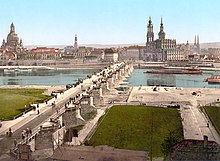History
Although Dresden is a relatively recent city of Germanic origin followed by settlement of
Slavic peoples,
[3] the area had been settled in the
Neolithic era by
Linear Pottery culture tribes ca.
7500 BC.
[4] Dresden's founding and early growth is associated with the
eastward expansion of Germanic peoples,
[3] mining in the nearby
Ore Mountains, and the establishment of the
Margraviate of Meissen. Its name etymologically derives from Old Sorbian
Drežďany, meaning
people of the forest. Dresden later evolved into the capital of
Saxony.
Early history
![[icon]](https://upload.wikimedia.org/wikipedia/commons/thumb/1/1c/Wiki_letter_w_cropped.svg/20px-Wiki_letter_w_cropped.svg.png) | This section requires expansion with: with the help of German wikipedia article. (March 2015) |
Around the late 12th century, a
Slavic settlement called
Drežďany[5]
had developed on the southern bank. Another settlement existed on the
northern bank, but its Slavic name is unclear. It was known as
Antiqua Dresdin by 1350, and later as Altendresden,
[5][6] both literally "old Dresden".
Dietrich, Margrave of Meissen, chose Dresden as his interim residence in 1206, as documented in a record calling the place "Civitas Dresdene".
After 1270, Dresden became the capital of the margraviate. It was restored to the
Wettin dynasty in about 1319. From 1485, it was the seat of the
dukes of Saxony, and from 1547 the
electors as well.
Modern age
The
Elector and ruler of Saxony Frederick
Augustus I became King
August the Strong of
Poland in
personal union. He gathered many of the best musicians,
[7]
architects and painters from all over Europe to Dresden. His reign
marked the beginning of Dresden's emergence as a leading European city
for technology and art. Dresden suffered heavy destruction in the
Seven Years' War (1756–1763), following its capture by Prussian forces, its subsequent re-capture, and a failed
Prussian siege in 1760.
Friedrich Schiller wrote his
Ode to Joy (the literary base of the
European anthem) for the Dresden
Masonic Lodge in 1785.
[citation needed]
The city of Dresden had a distinctive silhouette, captured in famous paintings by
Bernardo Bellotto and by Norwegian painter
Johan Christian Dahl. Between 1806 and 1918 the city was the capital of the
Kingdom of Saxony (which was a part of the
German Empire from 1871). During the
Napoleonic Wars the
French emperor made it a
base of operations, winning there the famous
Battle of Dresden on 27 August 1813. Dresden was a center of the
German Revolutions in 1848 with the
May Uprising, which cost human lives and damaged the historic town of Dresden.
[citation needed]
During the 19th century the city became a major center of economy, including
motor car production, food processing, banking and the manufacture of
medical equipment.
In the early 20th century Dresden was particularly well known for its
camera works and its cigarette factories. Between 1918 and 1934 Dresden
was capital of the first Free State of Saxony. Dresden was a center of
European
modern art until 1933.
Military history
During the foundation of the German Empire in 1871, a large military facility called Albertstadt was built.
[8] It had a capacity of up to 20,000
military personnel
at the beginning of the First World War. The garrison saw only limited
use between 1918 and 1934, but was then reactivated in preparation for
the Second World War.
Its usefulness was limited by attacks on 17 April 1945
[9] on the railway network (especially towards Bohemia).
[10] Soldiers had been deployed as late as March 1945 in the Albertstadt garrison.
The Albertstadt garrison became the headquarters of the
Soviet 1st Guards Tank Army in the
Group of Soviet Forces in Germany after the war. Apart from the
German army officers' school (
Offizierschule des Heeres), there have been no more
military units
in Dresden since the army merger during German reunification, and the
withdrawal of Soviet forces in 1992. Nowadays, the Bundeswehr operates
the
Military History Museum of the Federal Republic of Germany in the former Albertstadt garrison.


